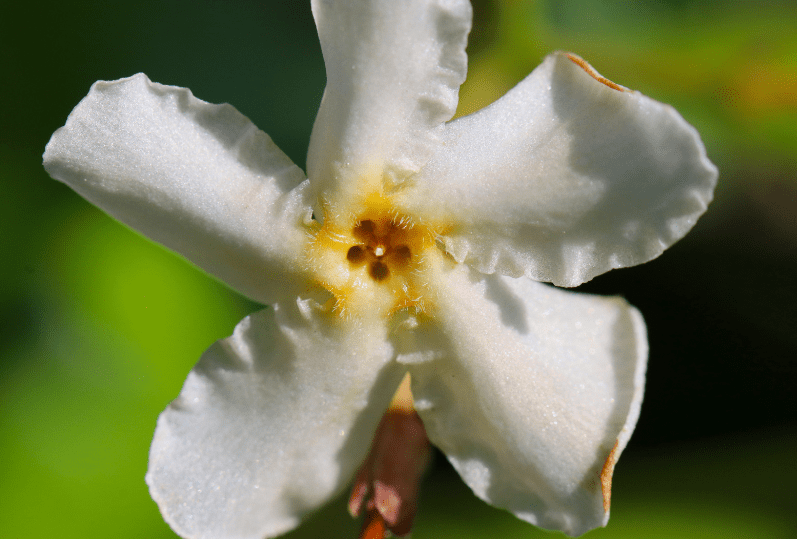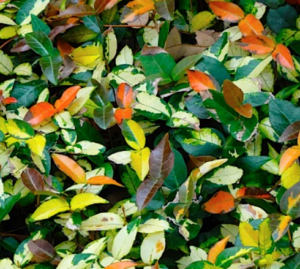
If you’re searching for a ground cover that thrives on minimal attention, Asiatic jasmine might be the perfect fit. This evergreen powerhouse flourishes in warm climates, creating a lush carpet of green while keeping weeds under control. It’s remarkably hardy and even tolerates salty coastal conditions. Ready to add this versatile beauty to your landscape? Let’s dive in!
What is Asiatic Jasmine?
Despite its name, this jasmine isn’t a true jasmine but shares the sweet fragrance of jasmine blooms. Native to Japan and Korea, this fast-spreading vine boasts small, dark green, leathery leaves. The leaves grow in opposite pairs along thin, wiry stems that take on a reddish-brown hue as they mature. In spring and summer, clusters of delicate, yellow, star-shaped flowers might appear, adding a delightful fragrance to the air.
How to Plant Asiatic Jasmine
Planting this groundcover is a breeze! Here’s a more detailed breakdown:
- Timing is Key: In warmer climates (USDA zones 7b-10), the best time to plant is fall. This allows the plants to establish strong roots before the summer heat arrives. Cooler climates can plant in spring once the threat of frost has passed.
- Location: This jasmine loves full sun for the most vibrant growth and potential blooms. However, it can tolerate some partial shade if needed.
- Soil Matters: While not overly fussy, this plant prefers well-drained soil. Avoid planting it in areas prone to staying soggy, as this can lead to root problems.
- Make Some Space: To allow your plants room to spread, space them 12 to 18 inches apart.
How to Care for Asiatic Jasmine
Once established, this groundcover is incredibly easygoing. Here’s how to keep it thriving:
- Water Wisely: Deeply water your young plants when the soil feels dry to the touch. Established plants are surprisingly drought-tolerant but still benefit from occasional watering during very dry periods.
- Fertilizer Friend: A balanced, slow-release fertilizer applied in early spring can give it a boost, but it thrives on neglect, so don’t feel pressured to over-fertilize!
- Keep it Trim: While it doesn’t need constant pruning, a good trim in late winter or early spring helps control its enthusiastic growth and keeps it looking its best.
Pests & Diseases to Watch
Lucky for you, this groundcover is remarkably tough! It rarely has major pest or disease issues. However, it’s good to keep an eye out for:
- Scale Insects: These small, armored pests can sometimes appear on stems.
- Fungal Diseases: Overly wet conditions may occasionally lead to fungal spots on leaves.
How to Use Asiatic Jasmine in Your Garden
The possibilities are endless! Here are some ideas:
- Luscious Groundcover: Perfect for filling in bare patches under trees, covering slopes, or adding greenery to difficult areas.
- Living Lawn: If you’re tired of mowing, It can be a low-maintenance, traffic-tolerant alternative to traditional grass.
- Spilling Beauty: Plant it in containers or hanging baskets and let its vines cascade over the sides for a waterfall of green.
- Border Patrol: Its low, spreading nature makes it a fantastic choice for edging flower beds or pathways.
What are Some of the Best Varieties of Asiatic Jasmine?
Looking to add a pop of color? These varieties are sure to please:

- Snow n Summer: This stunner boasts variegated leaves splashed with green, white, and vibrant pink. It’s a true eye-catcher!

- Summer Sunset: New growth on this variety starts as a fiery reddish-orange before maturing to a rich green. It adds a burst of warmth to the landscape.

- Tricolor: If you love variegation, this one’s for you. Tricolor’s leaves are a cheerful mix of green, pink, and cream.
Responsible Growth
Asiatic jasmine has invasive tendencies in some climates. Consider planting within defined borders like edging or using root barriers to keep it in check. Regular pruning also helps control its enthusiastic spread.
Multiplying Your Plants: Easy Propagation
Want more of this gorgeous groundcover? Here’s a simple method:
- Stem Cuttings: Take a 4-6 inch cutting from a healthy stem. Remove the lower leaves and dip the cut end in the rooting hormone (optional). Plant the cutting in moist potting mix or directly in a prepared garden bed. Keep the soil moist and the cutting in a bright but shaded location.
Final Word
Asiatic jasmine is a true gem for warm-climate gardens. It’s beautiful, tough, and incredibly low-maintenance. With a bit of understanding of its growth habits and simple care, you can enjoy this lush groundcover for years!
Have you grown Asiatic jasmine? Do you have any tips or tricks to share?


























